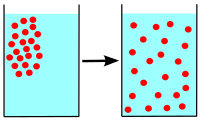
Photo from wikipedia
We consider a stochastic aggregation model on $$\mathbb {Z}^d$$Zd. Start with particles distributed according to the product Bernoulli measure with parameter $$\mu $$μ. In addition, start with an aggregate at… Click to show full abstract
We consider a stochastic aggregation model on $$\mathbb {Z}^d$$Zd. Start with particles distributed according to the product Bernoulli measure with parameter $$\mu $$μ. In addition, start with an aggregate at the origin. Non-aggregated particles move as continuous-time simple random walks obeying the exclusion rule, whereas aggregated particles do not move. The aggregate grows by attaching particles to its surface whenever a particle attempts to jump onto it. This evolution is called multi-particle diffusion limited aggregation. Our main result states that if on $$d>1$$d>1 the initial density of particles is large enough, then with positive probability the aggregate has linearly growing arms; that is, there exists a constant $$c>0$$c>0 so that at time t the aggregate contains a point of distance at least ct from the origin, for all t. The key conceptual element of our analysis is the introduction and study of a new growth process. Consider a first passage percolation process, called type 1, starting from the origin. Whenever type 1 is about to occupy a new vertex, with positive probability, instead of doing it, it gives rise to another first passage percolation process, called type 2, which starts to spread from that vertex. Each vertex gets occupied only by the process that arrives to it first. This process may have three phases: extinction (type 1 gets eventually surrounded by type 2), coexistence (infinite clusters of both types emerge), and strong survival (type 1 produces an infinite cluster which entraps all type 2 clusters). Understanding the various phases of this process is of mathematical interest on its own right. We establish the existence of a strong survival phase, and use this to show our main result.
Journal Title: Inventiones mathematicae
Year Published: 2019
Link to full text (if available)
Share on Social Media: Sign Up to like & get
recommendations!